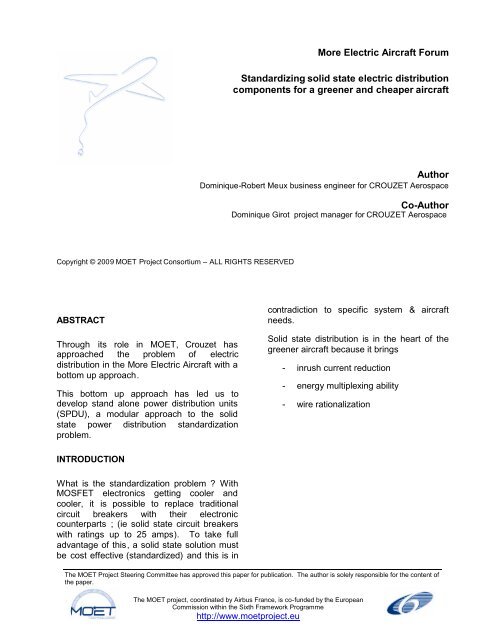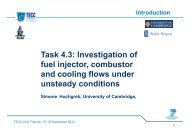More Electric Aircraft Forum Standardizing solid state electric ...
More Electric Aircraft Forum Standardizing solid state electric ...
More Electric Aircraft Forum Standardizing solid state electric ...
Create successful ePaper yourself
Turn your PDF publications into a flip-book with our unique Google optimized e-Paper software.
Copyright © 2009 MOET Project Consortium – ALL RIGHTS RESERVED<br />
ABSTRACT<br />
Through its role in MOET, Crouzet has<br />
approached the problem of <strong>electric</strong><br />
distribution in the <strong>More</strong> <strong>Electric</strong> <strong>Aircraft</strong> with a<br />
bottom up approach.<br />
This bottom up approach has led us to<br />
develop stand alone power distribution units<br />
(SPDU), a modular approach to the <strong>solid</strong><br />
<strong>state</strong> power distribution standardization<br />
problem.<br />
INTRODUCTION<br />
What is the standardization problem ? With<br />
MOSFET electronics getting cooler and<br />
cooler, it is possible to replace traditional<br />
circuit breakers with their electronic<br />
counterparts ; (ie <strong>solid</strong> <strong>state</strong> circuit breakers<br />
with ratings up to 25 amps). To take full<br />
advantage of this, a <strong>solid</strong> <strong>state</strong> solution must<br />
be cost effective (standardized) and this is in<br />
The MOET Project Steering Committee has approved this paper for publication. The author is solely responsible for the content of<br />
the paper.<br />
The MOET project, coordinated by Airbus France, is co-funded by the European<br />
Commission within the Sixth Framework Programme<br />
http://www.moetproject.eu<br />
<strong>More</strong> <strong>Electric</strong> <strong>Aircraft</strong> <strong>Forum</strong><br />
<strong>Standardizing</strong> <strong>solid</strong> <strong>state</strong> <strong>electric</strong> distribution<br />
components for a greener and cheaper aircraft<br />
Author<br />
Dominique-Robert Meux business engineer for CROUZET Aerospace<br />
Co-Author<br />
Dominique Girot project manager for CROUZET Aerospace<br />
contradiction to specific system & aircraft<br />
needs.<br />
Solid <strong>state</strong> distribution is in the heart of the<br />
greener aircraft because it brings<br />
- inrush current reduction<br />
- energy multiplexing ability<br />
- wire rationalization
WHY A GREENER AIRCRAFT ?<br />
Greener with inrush current reduction<br />
The soft start feature available on all <strong>solid</strong><br />
<strong>state</strong> protection lines illustrates the<br />
contribution of electronics to generator size<br />
reduction ; an illustration is given below with<br />
the recording of an incandescent light<br />
powering on :<br />
250 W 28V Landing light<br />
traditional power on<br />
250 W 28V Landing light<br />
power on with soft start<br />
The application of the above feature in<br />
conjunction with a sequential power on of<br />
loads contributes to reducing generator size<br />
thus weight and operator possession cost.<br />
Greener with flight phase management<br />
Copyright © 2009 MOET Project Consortium – ALL RIGHTS RESERVED<br />
Page 2 of 6<br />
<strong>More</strong> gains in cost and weight appear when a<br />
load management unit is used in conjunction<br />
with flight phases.<br />
energized loads vs flight phase<br />
Without multiplexing, the wire feeders must<br />
cope with the worst case (here marked with<br />
an x).<br />
Multiplexing is possible because a<br />
communicating Solid State Circuit Breaker<br />
(SSCB) is a switch, a relay and a current<br />
sensor at the same time:<br />
With these 3 intrinsic features an SSCB<br />
gives to the system energy multiplexing<br />
ability.<br />
Greener through modular architecture<br />
This has been of one the goals of MOET and<br />
is the standard now for large aircrafts [3].
“SOLID COSTS” CONSIDERATIONS<br />
Because of the lack of a standard, <strong>solid</strong> <strong>state</strong><br />
power distribution systems are generally<br />
taylorized and adapted. Because of this, the<br />
ratio between the cost of an SSCB line inside<br />
a <strong>solid</strong> <strong>state</strong> protection and the cost of an<br />
electromechanically protected line is 4:1. This<br />
is also illustrated in [2].<br />
The above ratio (4:1) is prohibitive when your<br />
SSCB line performs only a thermal protection<br />
(ie is just used as a circuit breaker).<br />
But as soon as an SSCB is used as a relay<br />
the ratio comes down to (1,5:1) because with<br />
your SSCB, you remove an LRU relay costing<br />
100 to 200 USD.<br />
Hidden gains appear when weight and wiring<br />
simplification come into the equation. Some<br />
studies show that weight gains of 20Kg can<br />
be possible on business jets [1]. For larger<br />
aircrafts, the wire simplification is<br />
preponderant [3] bringing the ratio to (1:1) or<br />
even lower.<br />
ACHIEVEMENTS THROUGH MOET<br />
Inside the MOET large aircraft 100m test rig<br />
Crouzet was assigned to 3 tasks :<br />
- adapt and support an SEPDC cabinet from<br />
the MODERNE project<br />
- develop two Stand Alone Power Distribution<br />
Units (SPDU) (28VDC and 115VAC 400Hz).<br />
- implement GFI and arc fault protection on<br />
the AC <strong>solid</strong> <strong>state</strong> devices<br />
Copyright © 2009 MOET Project Consortium – ALL RIGHTS RESERVED<br />
Page 3 of 6<br />
Secondary Power distribution Cabinet<br />
In order to mutualise thermal sink, power<br />
supplies and communication SSCB are<br />
clustered on power board :<br />
Crouzet has developed 115VAC, 230VAC,+-<br />
270VDC and 28VDC power boards. These<br />
boards have the same redundant architecture<br />
in order to attain the system security<br />
objectives.<br />
power board general architecture<br />
These boards communicate through CAN; A<br />
CAN/ AFDX concentrator developed by<br />
Zodiac Aerospace enables communication<br />
with the system and maintenance calculator<br />
level. The complete composition of an<br />
SEPDC cabinet is illustrated hereunder :
SEPDC : cabinet courtesy of Labinal<br />
Stand alone power distribution units<br />
The SPDU is our contribution to standardizing<br />
<strong>solid</strong> <strong>state</strong> distributions with off the shelf<br />
components & packaging.<br />
Copyright © 2009 MOET Project Consortium – ALL RIGHTS RESERVED<br />
Page 4 of 6<br />
Indeed,<br />
With the SPDU we have chosen the ARINC<br />
600 envelope as a standard packaging<br />
With the SPDU we have made a step<br />
towards a standardized software interface:<br />
The general queries and replies have been<br />
laid down and homogenized with other<br />
partners. Today there are around 16 queries<br />
and 16 answers possible when you question<br />
a cluster of SSCBs (ie a SPDU).<br />
SPDU Queries example<br />
This orders is addressed to each SPDU every 30 msec ; It<br />
sets the 24 SSCBs to ON or OFF.<br />
When receiving the above order, the SPDU replies with the<br />
effective <strong>state</strong> of each SSCB it controls (it can be open, closed<br />
or tripped thermally, on arc fault or ground fault) :
With the SPDU we have confirmed that off<br />
the shelf components can deliver<br />
performances equivalent to hybrid solutions<br />
Our previous 2001 technology was mixed<br />
hybrid and we have improved performances<br />
in the following way :<br />
GFI and arc fault protection features<br />
GFI technology required<br />
-the coordination of 3 AC SSCBs (to build a 3<br />
phase AC circuit breaker).<br />
-the monitoring of the homopolar current<br />
within the 3 phases, done with a current<br />
transformer.<br />
This is why an AC SPDU has 3 power<br />
feeders (phase 1, phase 2 and phase 3) and<br />
generally contains a number of SSCBs<br />
multiple of 3.<br />
Copyright © 2009 MOET Project Consortium – ALL RIGHTS RESERVED<br />
Page 5 of 6<br />
Arc fault technology was transferred inside<br />
the SPDU by compiling and linking the AC<br />
arc fault algorithm in C language already<br />
available in Crouzet, with each SSCB<br />
application.<br />
CONCLUSION<br />
With MOET we can now offer cost efficient<br />
equipments to the aircraft industry<br />
associating<br />
off the shell electronics<br />
off the shelf packaging<br />
a software interface that answers<br />
most needs and can be adapted
ACKNOWLEDGMENTS<br />
The MOET project is a European Project, cofunded<br />
by the European Commission within<br />
the Sixth Framework Programme.<br />
Crouzet thanks<br />
Labinal for their rack contribution and<br />
support<br />
Zodiac Aerospace as an active WP6<br />
manager and partner<br />
GE Aviation Cheltenham for sharing<br />
technological issues<br />
Airbus France for their coordination and<br />
fruitful innovation<br />
REFERENCES<br />
[1] Fred Potter -Astronics- “Solid <strong>state</strong> power<br />
distribution technology” AEISS (Aerospace<br />
<strong>Electric</strong>al Interconnect Symposium)<br />
Savannah 2007<br />
[2] Michael Walz –FAA- Aging <strong>Aircraft</strong><br />
Conference 2007 “A pricing analysis around<br />
<strong>solid</strong> <strong>state</strong> technology”<br />
[3] Mike Bailey –GE Aviation- Modular<br />
distribution considerations on large aircraft<br />
CONTACT<br />
dmeux@crouzet.com<br />
dgirot@crouzet.com<br />
Copyright © 2009 MOET Project Consortium – ALL RIGHTS RESERVED<br />
Page 6 of 6<br />
Definitions, Acronyms, Abbreviations<br />
AC :<br />
CB :<br />
GFI :<br />
MODERNE:<br />
Alternative Current<br />
Circuit Breaker<br />
Ground Fault Interrupter<br />
MOdular ElectRical<br />
NEtwork<br />
MOET <strong>More</strong> Open <strong>Electric</strong>al<br />
Technologies<br />
SEPDB :<br />
Secondary <strong>Electric</strong> Power<br />
Distribution Box<br />
SPDU: Stand Alone Power<br />
Distribution Unit<br />
SSCB :<br />
Solid State Circuit Breaker















